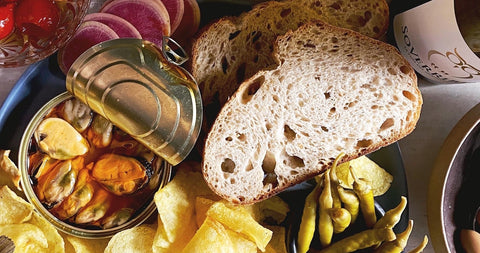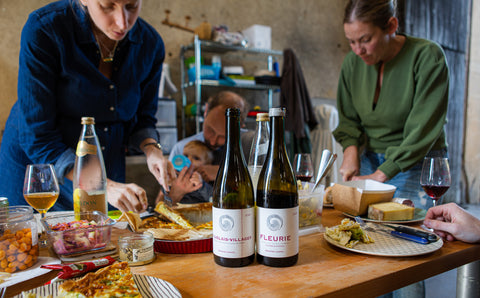We pack the shelves of our market with tinned fish of all shapes, colors and origins. Smoky sardines from Galicia, nuggets of juicy lobster from Maine, fire-roasted mussels drenched in vinegary escabeche sauce, tightly coiled octopus legs, the flakiest tuna bathed in lightly spiced tomato sauce, and more.
They come from all over — Norway, Maine, Italy — but when we think of what wines to pair with them, our first thought is of Spain. We think of the tiny seaside towns dotting the Galician coast where people have been brining, smoking, and grilling seafood to pack into tins for generations. Tinned fish might be trending today, but here, conserva has been a way of life for more than a century. Naturally, the local wines are often the perfect complement.
This is a list of our favorite pairings. We’ve also included explainers for why these pairings work. Give them a try and let us know what you think. Or, skip straight to the collection.
Squid in Ink with Mencia
One of the most distinctive, and classic, Galician conserva is calamares en su tinta (squid in its ink). Tiny pieces of tender octopus or squid are cooked and packed up tight in a glossy, jet-black bath of their own ink.
Calamares en su tinta pairs incredibly well with Mencia, a grape native to Galicia. Mencia gives the bold fresh fruit flavors you find in Beaujolais, with the hint of greenery you might find in a Cab Franc, all combined with a unique dose of crushed stone drenched in red berries and pomegranate to provide a luscious backbone that enlivens the inky squid.
Why This Pairing Works
Structure. The aromatic, fruit-forward, structured Mencia has the perfect backbone to pair with the rich squid ink pasta.
What grows together goes together. Regional cuisine and local wines tend to complement each other, no matter where you are in the world.
Need inspiration for how to eat calamares en su tinta? One of our favorites is Nero di Seppia, a Sicilian pasta dish.
Mussels and Albariño
Galician tinned mussels aren’t your average grocery aisle mollusk. Packed in a light escabeche sauce, olive oil, or salsa brava, they’re the perfectly balanced bite. Pair with Albariño, which comes from Rias Baixas, the coastal estuary where rivers meander from the Atlantic into the lush green interior of Galicia. Pairing with mussels is a hyper-local move — one that fully embraces the axiom of “What grows together goes together.”
Why This Pairing Works
Contrast. The umami flavor of the mussels contrasts with the crispness of the Albarino.
Acid + Acid. Acidic foods, like mussels packed in escabeche (a vinegar-based sauce), need wines with an equal or greater level of acidity.
Fat + Acid. If the mussels are packed in oil, the mouthwatering acidity of the Albariño will cut through that richness and act as a palate cleanser.
Razor Clams and Palomino
Razor clams are one of the most prized mollusks. They have a firm texture, delicate ivory color, and a flavor that calls to mind salty breezes on windswept shores. Pop a can and serve as is, with a squeeze of lemon and fresh bread, or in a seafood pasta dish with a healthy dose of fresh chopped herbs.
Whether they’re packed in brine or olive oil, we eat them with wines that complement their coastal identity. Slightly oxidative wines made from Palomino add the rich warmth of a golden sunset to the beachy, saline flavor of razor clams.
Why this Pairing Works
Matching intensity or dominant flavors. This is one of the principles of pairing, that your food and wine should match each other’s intensity, in this case, saltiness matches saltiness.
Sardines with Godello
Sardines might have fallen off the radar in the U.S. (before the rise of hot girl tinned fish), but they never fell off menus or shelves in Galicia and the rest of the Iberian peninsula. And with their silvery sides tightly packed into rich oils and tomato sauces, how could they?
Pair sardines with Godello. Generally, Godello is aromatic, citrusy, and slightly saline, but fuller-bodied than Albariño and with a healthy dose of minerality. If you happen to find a skin contact Godello, even better.
Why this Pairing Works
Contrast. The acidity and texture of Godello (especially a skin contact version) cuts through the mouth-coating effect of the fish, and its medium body ensures that the oiliness of the sardines won’t outweigh the wine.
What grows together goes together. This is a typical regional pairing — in Spain, Godello is often served with meatier fish.



